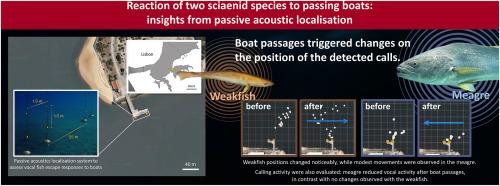Reaction of two sciaenid species to passing boats: Insights from passive acoustic localisation
IF 2.6
3区 地球科学
Q1 MARINE & FRESHWATER BIOLOGY
引用次数: 0
Abstract
Meagre (Argyrosomus regius) and weakfish (Cynoscion regalis) are two soniferous sciaenid species that use the Tagus estuary (Portugal) to breed. In this highly urbanized environment, fishes must deal with multiple anthropogenic stressors that include high noise levels caused by the intense boat traffic. We investigated how these sciaenids react to ferry boat and small boat passages, by assessing both changes in breeding calling activity with passive acoustic monitoring and escape responses with passive acoustic localisation. We found that meagre reduced calling activity after boat passages, but no such effect was observed in weakfish. Instead, weakfish moved in response to boat passages suggesting an escape response. Meagre also changed positions and dispersion patterns, but movements were more modest. This study uses a cost-effective and non-invasive passive acoustic localisation method to elucidate the behavioural response of soniferous fish to anthropogenic noise for the first time, contributing to our understanding of the way fish react to this stressor. Such knowledge is especially important in contexts where fish are exposed to highly prevalent human-generated noise during the breeding season, such as in busy estuaries and coastal areas.

两种鲷科鱼类对过往船只的反应:被动声学定位的启示
鲶鱼(Argyrosomus regius)和弱鱼(Cynoscion regalis)是利用塔霍河口(葡萄牙)繁殖的两种声鳞鱼类。在这个高度城市化的环境中,鱼类必须应对多种人为压力,其中包括密集的船只交通造成的高噪音水平。我们通过被动声学监测和被动声学定位来评估繁殖叫声活动的变化,从而研究了这些笛鲷对渡船和小船通过时的反应。我们发现,小船驶过后,蓑鲉的叫声活动会减少,但在弱鱼身上却观察不到这种影响。相反,弱鱼在船只通过时会移动,这表明弱鱼有逃避反应。鲶鱼也会改变位置和分散模式,但移动幅度较小。这项研究首次使用了一种经济有效的非侵入式被动声学定位方法来阐明声鳍鱼类对人为噪声的行为反应,有助于我们了解鱼类对这种压力源的反应方式。这些知识对于鱼类在繁殖季节暴露于人类产生的高频噪声的环境尤为重要,例如在繁忙的河口和沿海地区。
本文章由计算机程序翻译,如有差异,请以英文原文为准。
求助全文
约1分钟内获得全文
求助全文
来源期刊
CiteScore
5.60
自引率
7.10%
发文量
374
审稿时长
9 months
期刊介绍:
Estuarine, Coastal and Shelf Science is an international multidisciplinary journal devoted to the analysis of saline water phenomena ranging from the outer edge of the continental shelf to the upper limits of the tidal zone. The journal provides a unique forum, unifying the multidisciplinary approaches to the study of the oceanography of estuaries, coastal zones, and continental shelf seas. It features original research papers, review papers and short communications treating such disciplines as zoology, botany, geology, sedimentology, physical oceanography.

 求助内容:
求助内容: 应助结果提醒方式:
应助结果提醒方式:


